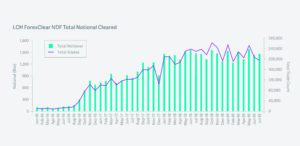
Tamaryn Nuttall, chief operating officer, LCH ForexClear
How do the uncleared margin rules (UMR) affect the buy-side?
Tamaryn Nuttall: The UMR will have a significant impact on the buy-side. Asset managers that are caught under the UMR will be required to exchange initial and variation margin with each of their counterparties for their derivative transactions. Compliance brings with it complexity, as each firm will need to calculate the exact amount of margin needed to pay to each of those counterparties on a daily basis.
There’s also an operational impact of setting up new processes to support compliance with the UMR. The rules require firms to set up new documentation and new company accounts. Asset managers may also need to implement new technologies to manage funding where margin is posted between two counterparties.
More broadly, there is also a wider industry impact of the UMR implementation. These rules have been rolled out in phases since 2016, and since then we’ve seen a significant increase in cleared volume in specific derivatives products. For example, LCH has seen a significant increase in clearing volumes for FX non-deliverable forwards (NDFs) over the last three years, now averaging $75bn per day. More recently, clearing volumes of deliverable FX Options have been steadily building since the launch of our service last year.
Beyond the risk management and compliance benefits of clearing, buy-side firms may also begin to see some price differentials between cleared and non-cleared trading activity. The financial cost of keeping the transactions bilateral can be reflected in the pricing that asset managers receive and can affect their access to liquidity.
While the implementation of the UMR’s final phase has recently been postponed to 2021, there is certainly still scope for the buy-side to engage in preparation before the rules come into force. We’ve seen the sell-side leading the way when it comes to using clearing to prepare for the UMR and benefit from multilateral netting. There is now a clear opportunity for the buy-side to make the same gains.
Firms should be considering whether there are actions that they can take that will keep them beneath the UMR thresholds now, before the calculation for clearing starts in phase six. For example, some asset managers may have a portion of their portfolio that they could pass through a clearinghouse. As a result, those transactions would not be included in the aggregate average notional amount (AANA) potentially removing them from scope of UMR.
What is the role of clearing?
TN: The primary role of clearing is to provide counterparty risk management to its members and their clients. By accessing a single pool of liquidity through a CCP, participants are also able to benefit from capital, operational and margin efficiencies that they would otherwise not be able to achieve in a non-cleared environment.
More specifically related to the UMR, by clearing transactions at a CCP, those trades may no longer contribute to the AANA calculation, meaning that their derivatives activity may come in beneath the phasing threshold. Running an early analysis may also demonstrate to a firm whether there is opportunity to clear a portion of their portfolio which may consequently bring them out of scope for that phase of the UMR.
Clearing at ForexClear provides very effective netting at the portfolio level, which means that all of a firm’s cleared transactions can be netted together under a single counterparty. Posting cleared margin for these netted portfolios is cheaper than bilateral margin. Many buy-side firms are already running our portfolio margin simulation to project the potential savings that can be achieved.
A CCP can also help firms simplify or solve the operational challenges associated with getting set up for UMR, as such only requires an asset manager to prepare contractual documents with one single counterparty (such as LCH) as opposed to setting up complex documentation with each of their trading partners. In addition, firms are able to settle initial and variation margin while benefitting from netting facilitated by the central counterparty.
Put simply, clearing removes much of the complexity in the bilateral trading space that has the potential to become even more complicated under UMR.
What actions do you think firms should be taking?
TN: Early preparation is absolutely key due to the sheer amount of operational set-up that firms will have to complete in order to comply with the UMR. The first priority should be to understand which phase of the UMR the firm must comply with. Once that’s clear, asset managers should begin to take advantage of the opportunities available to optimise their portfolios with the aim of keeping their activity beneath the threshold.
Running in-depth portfolio analysis, and AANA calculations, is also key in understanding which parts of a portfolio are able to be cleared. In many cases, it may be cheaper for firms to move an entire portfolio to clearing.
Firms should also be looking at what products within the uncleared bilateral pool are clearable. At LCH ForexClear, we clear FX NDF products for sell-side members and buy-side clients. For FX Options, we operate a deliverable FX service for dealers, and we are aiming to expand our offering to launch non-deliverable options clearing in 2020. Some clients are looking at product substitution to optimise their portfolios, and as a result we are seeing piqued interest in clearing G10 NDF products at LCH. Similarly, we believe non-deliverable options could be a useful product for substituting deliverable FX options where appropriate.
Source: LCH
